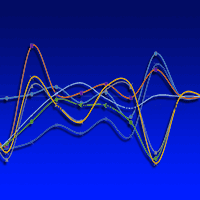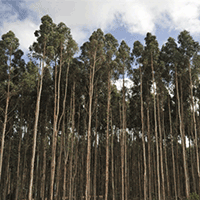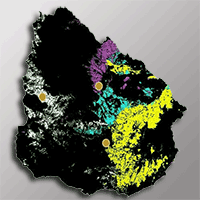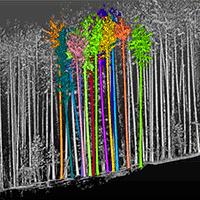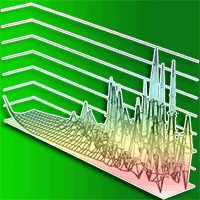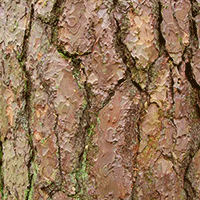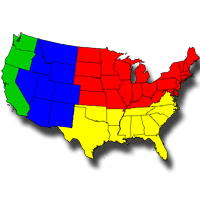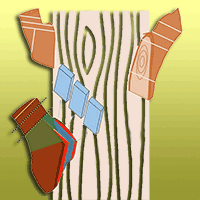Bottomland hardwoods are among the most diverse and productive forest ecosystems in the southeastern United States and are critically important for the provision of timber and non-timber ecosystem services. Red oaks, the dominant species in this group of forests, are of high ecological and economic value. Stem profile models are essential for accurately estimating the merchantable volume of oak trees, which is also closely indicative of total tree biomass and other ecosystem services given their allometric relationships. This study aims to develop and compare stem profiles among three red oak species in an 18-year old plantation forest using destructive sampling. Sixty trees randomly selected from an oak restoration plantation in the Arkansas Delta were felled for measuring the diameter-outside-bark (DOB) and diameter-inside-bark (DIB) at different stem heights. These sample composed of twenty trees from each of three species: cherry bark oak (CBO - Quercus pagoda Raf), Nuttall oak (NUT - Quercus texana Buckley), and Shumard oak (SHU - Quercus shumardii Buckl). Multiple models, including the segmented-profile model, form-class profile model, and second-and third-order polynomial models were fitted and compared. Results demonstrate that the form-class profile model was the best fitted for CBO and NUT, whereas the third-order polynomial model was the best for SHU. CBO tends to grow taller and has a higher wood density than NUT and SHU. These findings will inform restoration and management decisions of bottomland hardwood forests, especially red oaks in the region.
Keywords
, , , , ,
Citation
Tian N, Gan J, Pelkki M (2022). Stem profile of red oaks in a bottomland hardwood restoration plantation forest in the Arkansas Delta (USA). iForest 15: 179-186. - doi: 10.3832/ifor4057-015
Academic Editor
Agostino Ferrara
Paper history
Received: Jan 05, 2022
Accepted: Apr 05, 2022
First online: May 19, 2022
Publication Date: Jun 30, 2022
Publication Time: 1.47 months
© SISEF - The Italian Society of Silviculture and Forest Ecology 2022
Open Access
This article is distributed under the terms of the Creative Commons Attribution-Non Commercial 4.0 International (https://creativecommons.org/licenses/by-nc/4.0/), which permits unrestricted use, distribution, and reproduction in any medium, provided you give appropriate credit to the original author(s) and the source, provide a link to the Creative Commons license, and indicate if changes were made.

Breakdown by View Type
(Waiting for server response...)
Article Usage
Total Article Views: 29827
(from publication date up to now)
Breakdown by View Type
HTML Page Views: 26080
Abstract Page Views: 1891
PDF Downloads: 1407
Citation/Reference Downloads: 0
XML Downloads: 449
Web Metrics
Days since publication: 1320
Overall contacts: 29827
Avg. contacts per week: 158.17
Article Citations
Article citations are based on data periodically collected from the Clarivate Web of Science web site
(last update: Mar 2025)
Total number of cites (since 2022): 2
Average cites per year: 0.50
Publication Metrics
by Dimensions ©
Articles citing this article
List of the papers citing this article based on CrossRef Cited-by.
(1)
Alkan O, Ozçelik R (2020)Stem taper equations for diameter and volume predictions of
Abies cilicica Carr. in the Taurus Mountains, Turkey. Journal of Mountain Science 17 (12): 3054-3069.
CrossRef |
Gscholar
(2)
Allen JA (1997)Reforestation of bottomland hardwoods and the issue of woody species diversity. Restoration Ecology 5 (2): 125-134.
CrossRef |
Gscholar
(3)
Avery TE, Burkhart HE (2002)Forest Measurements. McGraw-Hill series in forest resources. McGraw-Hill, Boston, MS, USA, pp. 456.
Gscholar
(4)
Brooks JR, Jiang L, Ozcelik J (2008)Compatible stem volume and taper equations for Brutian pine, Cedar of Lebanon, and Cilicica fir in Turkey. Forest Ecology and Management 256: 147-151.
CrossRef |
Gscholar
(5)
Bruce D, Curtis RO, Vancoevering C (1968)Development of a system of taper and volume tables for red alder. Forest Science 14 (3): 339-350.
Online |
Gscholar
(6)
Cao QV, Burkhart HE, Max TA (1980)Evaluation of two methods for cubic-volume prediction of loblolly pine to any merchantable limit. Forest Science 26: 71-80.
Online |
Gscholar
(7)
Cao QV (2009)Calibrating a segmented taper equation with two diameter measurements. South Journal of Application Forest 33 (2): 58-61.
CrossRef |
Gscholar
(8)
Clark A, Souter RA, Schlaegel BE (1991)Stem profile equations for southern tree species. Res. Pap. SE-282, USDA Forest Service, Southeastern Forest Experiment Station, Asheville, NC, USA, pp. 113.
Online |
Gscholar
(9)
EPA (2016)Bottomland hardwoods. Environmental Protection Agency, Washington, DC, USA, pp. 10.
Online |
Gscholar
(10)
Fang Z, Borders BE, Bailey RL (2000)Compatible volume taper models for loblolly and slash pine based on system with segmented-stem form factors. Forest Science 46: 1-12.
Online |
Gscholar
(11)
Gordon AD, Lundgren C, Hay E (1996)Development of a composite taper equation to predict over-and under-bark diameter and volume of
Eucalyptus saligna in New Zealand. New Zealand Journal of Forest Science 25 (3): 318-327. -
Online |
Gscholar
(12)
Gordon HA, Connor KF, Haywood JD (2015)Proceedings of the 17th biennial Southern Silvicultural Research Conference. e-Gen. Tech. Rep. SRS-203, USDA Forest Service, Southern Research Station, Asheville, NC, USA, pp. 551.
CrossRef |
Gscholar
(13)
Goulding CJ, Murray JC (1976)Polynomial taper equations that are compatible with tree volume equations. New Zealand Journal of Forest Science 5 (3): 313-322.
Online |
Gscholar
(14)
Gómez-García E, Crecente-Campo F, Diéguez-Aranda U (2013)Selection of mixed-effects parameters in a variable-exponent taper equation for birch trees in northwestern Spain. Annals of Forest Science 70: 707-715.
CrossRef |
Gscholar
(15)
Hilt DE (1980)Taper-based system for estimating stem volume of upland oaks. Res. Pap. NE-458, USDA Forest Service, Beltsville, MD, USA, pp. 12.
Online |
Gscholar
(16)
Husch B, Miller CI, Beers TW (1972)Forest mensuration (2nd edn). Ronald Press, New York, USA, pp. 410.
Gscholar
(17)
Jiang L, Brooks JR, Wang J (2005)Compatible taper and volume equations for yellow-poplar in West Virginia. Forest Ecology Management 213: 399-409.
CrossRef |
Gscholar
(18)
Kellison RC, Young MJ (1997)The bottomland hardwood forest of the southern United States. Forest Ecology and Management 90 (2-3): 101-115.
CrossRef |
Gscholar
(19)
Kozak A, Munro DO, Smith JHG (1969)Taper functions and their application in forest inventory. Forest Chronicle 45: 278-283.
CrossRef |
Gscholar
(20)
Kozak A (2004)My last words on taper equations. Forestry Chronicle 80 (4): 507-515.
CrossRef |
Gscholar
(21)
Lee WK, Seo JH, Son YM (2003)Modeling stem profiles for
Pinus densiflora in Korea. Forest Ecology and Management 172 (1): 69-77.
CrossRef |
Gscholar
(22)
Leites LP, Robinson AP (2004)Improving taper equations of loblolly pine with crown dimensions in a mixed-effects modeling framework. Forest Science 50 (2): 204-212.
Online |
Gscholar
(23)
Lockhart BR, Guldin JM, Foti T (2010)Tree species composition and structure in an old bottomland hardwood forest in South-Central Arkansas. Castanea 75 (3): 315-329.
CrossRef |
Gscholar
(24)
MacDonald PO, Frayer WE, Clauser JK (1979)Documentation, chronology, and future projections of bottomland hardwood habitat loss in the Lower Mississippi alluvial Plain (vols. 1 and 2). US Fish and Wildlife Service, Vicksburg, MS, USA, pp. 124.
Online |
Gscholar
(25)
Matney TG, Parker RC (1992)Profile equations for several hardwood species to variable top diameter limits. Southern Journal of Applied Forestry 16 (2): 75-78.
CrossRef |
Gscholar
(26)
Matney TG (1996)TProfile. World Wide Heuristic Solutions, Starkville, MS, USA, pp. 24.
Gscholar
(27)
Max TA, Burkhart HE (1976)Segmented polynomial regression applied to taper equations. Forest Science 22 (3): 283.
Online |
Gscholar
(28)
Methol RJ (2001)Comparisons of approaches to modelling tree taper, stand structure and stand dynamics in forest plantations. Ph.D. thesis. University of Canterbury, Christchurch, New Zealand, pp. 298.
Online |
Gscholar
(29)
Muhairwe CK, Lemay VM, Kozak A (1994)Effects of adding tree, stand, and site variables to Kozak’s variable-exponent taper equation. Canadian Journal of Forest Research 24 (2): 252-259.
CrossRef |
Gscholar
(30)
Newnham R (1988)A variable-form taper function. Report PI-X-83, Petawawa National Forestry Institute, Canadian Forest Service, Canada, pp. 83.
Gscholar
(31)
Ormerod DW (1973)A simple bole model. Forestry Chronicle 49: 136-138.
CrossRef |
Gscholar
(32)
Ounekham K (2009)Developing volume and taper equations for
Styrax tonkinensis in Laos. Thesis, University of Canterbury, Christchurch, New Zealand, pp. 77.
Online |
Gscholar
(33)
Ozçelik R, Brooks JR, Jiang L (2011)Modeling stem profile of Lebanon cedar, Brutian pine, and Cilicica fir in Southern Turkey using nonlinear mixed-effects models. European Journal of Forest Research 130: 613-621.
CrossRef |
Gscholar
(34)
Parker RC (1997)Nondestructive sampling applications of the Tele-Relaskop in forest inventory. Southern Journal of Applied Forestry 21 (2): 75-83.
CrossRef |
Gscholar
(35)
Rauscher HM, Young MJ, Webb CD, Robison DJ (2000)Testing the accuracy of growth and yield models for southern hardwood forests. Southern Journal of Applied Forestry 24 (3): 176-185.
CrossRef |
Gscholar
(36)
Rupsys P, Petrauskas E (2010)Development of q-exponential models for tree height, volume and stem profile. Physical Science International Journal 5 (15): 2369-2378.
Gscholar
(37)
Saarinen N, Kankare V, Pyörälä J, Yrttimaa T, Liang X, Wulder MA, Holopainen M, Hyyppä J, Vastaranta M (2019)Assessing the effects of sample size on parametrizing a taper curve equation and the resultant stem-volume estimates. Forests 10 (10): 848.
CrossRef |
Gscholar
(38)
Saikku M (1996)Down by the riverside: the disappearing bottomland hardwood forest of southeastern North America. Environment and History 2 (1): 77-95.
CrossRef |
Gscholar
(39)
SAS Institute Inc. (2002)SAS/ETS User’s Guide, Version 9.0. SAS Institute Inc., Cary, NC, USA, pp. 125.
Gscholar
(40)
Sharma M, Burkhart HE (2003)Selecting a level of conditioning for the segmented polynomial taper equation. Forest Science 49: 324-330.
Online |
Gscholar
(41)
Stein J, Binion D, Acciavatti R (2003)Field guide to native oak species in Eastern North America. USDA Forest Service, Forest Health Technology Enterprise Team, Morgantown, WV, USA, pp. 54.
Online |
Gscholar
(42)
Tian N, Fan Z, Matney FG, Schultz EB (2017)Growth and stem profiles of invasive
Triadica sebifera in the Mississippi coast of the United States. Forest Science 63 (6): 569-576.
CrossRef |
Gscholar
(43)
VanderSchaaf CL, Burkhart HE (2007)Comparison of methods to estimate Reineke’s maximum size-density relationship species. Forest Science 53: 435-442.
Online |
Gscholar
(44)
Von Gadow K, Real P, Alvarez-Gonzalez JG (2001)Modelizacion del crecimiento y la evolucion de los bosques [Modeling of the growth and evolution of forests]. IUFRO World Series, Vienna, Austria, pp. 242. [in Spanish]
Gscholar
(45)
Westfall JA, Scott CT (2010)Taper models for commercial tree species in the northeastern United States. Forest Science 56 (6): 515-528.
Online |
Gscholar
(46)
Yang Y, Huang S, Trincado G, Meng SX (2009)Nonlinear mixed effects modeling of variable-exponent taper equations for lodgepole pine in Alberta, Canada. European Journal of Forest Research 128: 415-429.
CrossRef |
Gscholar
(47)
Zakrzewski WT, MacFarlane DW (2006)Regional stem profile model for crossborder comparisons of harvested red pine (
Pinus resinosa Ait.) in Ontario and Michigan. Forest Science 52: 468-475.
Online |
Gscholar
